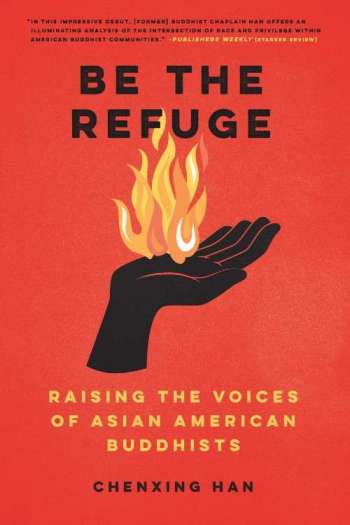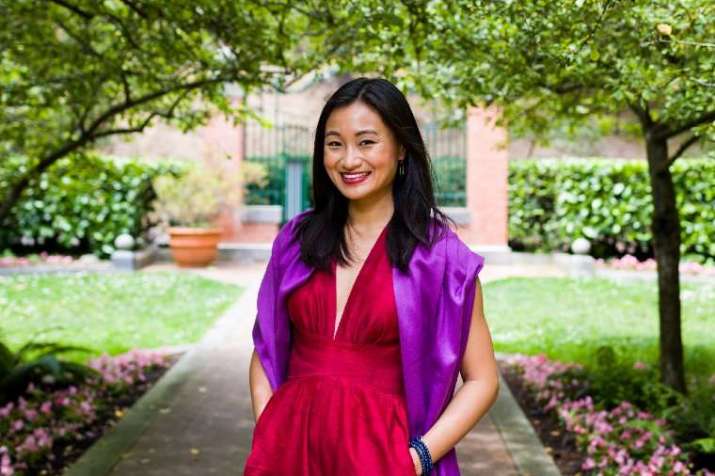With the rise in hate crimes against Asian communities since the start of the COVID-19 pandemic, it has become vividly apparent that North American society has in many ways failed people of Asian descent. Often considered a “model minority” in the US, the voices and lived experiences of Asian communities have long been overlooked—and Buddhism is no exception to this sad state of affairs. Despite accounting for a more than two-thirds of US Buddhists, Asian Americans rarely feature in mainstream representations of Buddhism, while white, middle-class people dominate the scene. Here to change this is Chenxing Han, who masterfully and compassionately showcases the experiences of Asian American Buddhists in her book Be the Refuge: Raising the Voices of Asian American Buddhists (North Atlantic Books 2021).
Han, who identifies as an Asian American woman, grew up in an atheist household and gradually came to adopt Buddhist beliefs and practices. She holds an MA in Buddhist studies from The Graduate Theological Union and she studied Buddhist chaplaincy at the Institute of Buddhist Studies in Berkeley, California. Instead of relating to the more Judeo-Christian notion of “conversion,” Han likens her spiritual transition to a gentle dimming of the light. She offers another metaphor:
It’s hard to pinpoint an exact moment when I “converted” to Buddhism. It was more of a gradual steeping, Buddhism suffusing my life the way tea remakes water, a subtle flavor intensifying over time. (127)
Despite attending numerous Buddhist sanghas of various denominations, Han reports that—in stark contrast to her white partner Trent—she often felt insecure and out of place at Buddhist places of worship. A big contributing factor to this was that she rarely came across peers in these settings. Han writes:
At majority-Asian temples, the preschool-to-retirement-age bracket was sparsely populated at best. Nor was I meeting many young adults, much less Asian Americans, at the majority-white Zen and insight meditation communities I frequented.
I began to wonder: Where are all the young adult Asian American Buddhists? (6)
As she went about her exploration of Buddhism, it became clear to Han that there exists a “tale of two separate (and apparently not equal) Buddhisms” whereby white converts are viewed as engaging in rational and engaged Buddhist practices, while Buddhists of Asian descent are portrayed as being conservative, superstitious, ritualistic, and passive. (11) This widely accepted but very limited view about Buddhism in the US led to feelings of confusion and loneliness, and spurred Han to interview 89 young pan-ethnic and pan-Buddhist adults for her master’s thesis—a seven-year project that culminated in Be the Refuge.
 Be the Refuge. Image courtesy of North Atlantic Books
Be the Refuge. Image courtesy of North Atlantic BooksAlthough the research is extensive, Be the Refuge is not academic in style. Following the advice of Zen Buddhist priest, author, and filmmaker Ruth Ozeki, Han proceeded to “put [herself]” into the book and made it an “account of [her] curiosity.” (222) The result is delightful: not only does it provide insight into a very real woman’s experience of Buddhism, it also highlights the meaningful connections that Han makes along the way. Additionally, it is a poetic work, for example, Han juxtaposes scenes of worship with the interviews, providing the reader with the sense that they are right there experiencing Buddhism alongside the young interviewees.
The book is comprised of an introduction, followed by 12 chapters as well as appendices and a bibliography. The appendices feature information about Han’s research methodology, including a list of interview questions as well as a list of the interviewees and their ethnicities.The chapters are divided into four sections: Trailblazers, which “centers the experiences of multi-generation Jodo Shinshu Buddhists whose Japanese American forebears brought Shin Buddhism to America more than a century ago;” Bridge-Builders which “focuses on the insights of second-generation Asian American Buddhists whose first-generation immigrant parents raised them within the Buddhist faith;” Integrators which “highlights the perspectives of Asian American converts;” and Refuge-Makers, which “draws from the voices of the first-gen, second-gen, and multi-gen interviewees in the previous chapters to explore the possibilities of a pan-ethnic, pan-sectarian Asian American Buddhist identity.” (15–17)
By creating an open and inclusive dialogue about race and identity with her interviewees, Han provides insight into the undeniable contributions that Asian communities have had on Buddhism in the US. Additionally, she demonstrates that young Asian American Buddhists cannot be put into a rigid box; instead they represent a diverse and fluid group, whose occupations, socioeconomic statuses, geographical locations, ethnicities, and practices vary widely. Her approach reverberates with the Buddhist values of wisdom and compassion; it is not about agreeing with the views of each interviewee, but rather about providing them with a space to express their experiences and to explore possibilities for more inclusive representations of Buddhism. As one of Han’s interviewees, Holly, explains:
Buddhists like myself face challenges in integrating and expressing multiple cultural identities—as young, American, Buddhist, and Asian. Yet I think we are all moving toward a more pluralistic world in which multiplicity of identity will be the norm. (111)
This wonderful and hopeful sentiment is shared by many of the other young people that Han interviews, including the author herself. In my opinion, Be the Refuge is a must-read for anyone who is interested in learning about the roots of Buddhism in the US, and who is invested in the future of Buddhism in this country.
Reference
Han, Chenxing. 2021. Be the Refuge: Raising the Voices of Asian American Buddhists. Berkeley, California: North Atlantic Books.
Related features from Buddhistdoor Global
Buddhistdoor View: Beyond Boundaries, Beyond Fear – Responding to a Rise in Hate
Green Shoots of Hope: Youth Climate Leaders in Asia and Africa
For Our Children’s Sake: Dismantling Racism and Bias in Schools
Ignorance in the Era of COVID-19: Society’s Failure to Protect Black Communities in the US
Toward Liberation: Dismantling Racism and Bias in the Sangha
Buddhistdoor View: Finding the Right Balance with Social Justice Causes
“Hyphenated-American”
Related news reports from Buddhistdoor Global
North American Buddhists to Offer Memorial Ceremony for Asian American Ancestors on 4 May
Naropa University in Colorado Celebrates First Black Futures Month
Soka Gakkai President Calls for Support on Nuclear Disarmament and Youth Climate Action
7th TLKY Canada Foundation Conference Held at University of British Columbia on 4 November
China’s Latest Viral Sub-culture Dubbed “Buddhist Youth”
Related videos from Buddhistdoor Global
Reflections on Recent Anti-Asian Violence: A BDG News Highlight (Youtube)
















